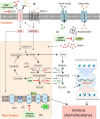Targeting chemoresistance and mitochondria-dependent metabolic reprogramming in acute myeloid leukemia
- PMID: 37746249
- PMCID: PMC10513429
- DOI: 10.3389/fonc.2023.1244280
Targeting chemoresistance and mitochondria-dependent metabolic reprogramming in acute myeloid leukemia
Abstract
Chemoresistance often complicates the management of cancer, as noted in the instance of acute myeloid leukemia (AML). Mitochondrial function is considered important for the viability of AML blasts and appears to also modulate chemoresistance. As mitochondrial metabolism is aberrant in AML, any distinct pathways could be directly targeted to impact both cell viability and chemoresistance. Therefore, identifying and targeting those precise rogue elements of mitochondrial metabolism could be a valid therapeutic strategy in leukemia. Here, we review the evidence for abnormalities in mitochondria metabolic processes in AML cells, that likely impact chemoresistance. We further address several therapeutic approaches targeting isocitrate dehydrogenase 2 (IDH2), CD39, nicotinamide phosphoribosyl transferase (NAMPT), electron transport chain (ETC) complex in AML and also consider the roles of mesenchymal stromal cells. We propose the term "mitotherapy" to collectively refer to such regimens that attempt to override mitochondria-mediated metabolic reprogramming, as used by cancer cells. Mounting evidence suggests that mitotherapy could provide a complementary strategy to overcome chemoresistance in liquid cancers, as well as in solid tumors.
Keywords: acute myeloid leukemia; chemoresistance; metabolic reprogramming; mitochondrial metabolism; mitotherapy.
Copyright © 2023 Feng, Zhang, Gao, Yu and Robson.
Conflict of interest statement
WG is the founder and directs the Antagen Institute for Biomedical Research. SR is a scientific founder of Purinomia Biotech Inc and consults for eGenesis, AbbVie and SynLogic Inc; his interests are reviewed and managed by HMFP at Beth Israel Deaconess Medical Center in accordance with the conflict-of-interest policies. The remaining authors declare that the research was conducted in the absence of any commercial or financial relationships that could be construed as a potential conflict of interest.
Figures



Similar articles
-
Interleukin-6 Facilitates Acute Myeloid Leukemia Chemoresistance via Mitofusin 1-Mediated Mitochondrial Fusion.Mol Cancer Res. 2023 Dec 1;21(12):1366-1378. doi: 10.1158/1541-7786.MCR-23-0382. Mol Cancer Res. 2023. PMID: 37698549
-
Reductive TCA cycle catalyzed by wild-type IDH2 promotes acute myeloid leukemia and is a metabolic vulnerability for potential targeted therapy.J Hematol Oncol. 2022 Mar 21;15(1):30. doi: 10.1186/s13045-022-01245-z. J Hematol Oncol. 2022. PMID: 35313945 Free PMC article.
-
FBP1-Altered Carbohydrate Metabolism Reduces Leukemic Viability through Activating P53 and Modulating the Mitochondrial Quality Control System In Vitro.Int J Mol Sci. 2022 Sep 27;23(19):11387. doi: 10.3390/ijms231911387. Int J Mol Sci. 2022. PMID: 36232688 Free PMC article.
-
Contribution of metabolic abnormalities to acute myeloid leukemia pathogenesis.Trends Cell Biol. 2023 Jun;33(6):455-462. doi: 10.1016/j.tcb.2022.11.004. Epub 2022 Dec 5. Trends Cell Biol. 2023. PMID: 36481232 Review.
-
[Recent advances in the study of potential mitochondria-related therapeutic targets in acute myeloid leukemia].Sheng Li Xue Bao. 2024 Aug 25;76(4):605-621. Sheng Li Xue Bao. 2024. PMID: 39192793 Review. Chinese.
Cited by
-
Acute myeloid leukemia mitochondria hydrolyze ATP to resist chemotherapy.bioRxiv [Preprint]. 2024 Nov 11:2024.04.12.589110. doi: 10.1101/2024.04.12.589110. bioRxiv. 2024. Update in: Sci Adv. 2025 Apr 11;11(15):eadu5511. doi: 10.1126/sciadv.adu5511. PMID: 38659944 Free PMC article. Updated. Preprint.
-
Acute myeloid leukemia mitochondria hydrolyze ATP to support oxidative metabolism and resist chemotherapy.Sci Adv. 2025 Apr 11;11(15):eadu5511. doi: 10.1126/sciadv.adu5511. Epub 2025 Apr 9. Sci Adv. 2025. PMID: 40203117 Free PMC article.
-
The ALDH2/PolG2 axis enhances mitochondrial biogenesis via transcriptional regulation of Nrf2 and promotes chemotherapy resistance in acute myeloid leukaemia.Cell Death Dis. 2025 Aug 13;16(1):616. doi: 10.1038/s41419-025-07927-z. Cell Death Dis. 2025. PMID: 40796730 Free PMC article.
-
STX1A regulates ferroptosis and chemoresistance in gastric cancer through mitochondrial function modulation.Hum Cell. 2025 Mar 8;38(3):66. doi: 10.1007/s13577-025-01195-x. Hum Cell. 2025. PMID: 40056239
-
Cheminformatic identification of small molecules targeting acute myeloid leukemia.bioRxiv [Preprint]. 2025 May 24:2025.05.20.655224. doi: 10.1101/2025.05.20.655224. bioRxiv. 2025. PMID: 40475511 Free PMC article. Preprint.
References
-
- Lancet JE, Uy GL, Cortes JE, Newell LF, Lin TL, Ritchie EK, et al. . CPX-351 (cytarabine and daunorubicin) liposome for injection versus conventional cytarabine plus daunorubicin in older patients with newly diagnosed secondary acute myeloid leukemia. J Clin Oncol (2018) 36:2684–92. doi: 10.1200/JCO.2017.77.6112 - DOI - PMC - PubMed
Publication types
Grants and funding
LinkOut - more resources
Full Text Sources
Research Materials
Miscellaneous

